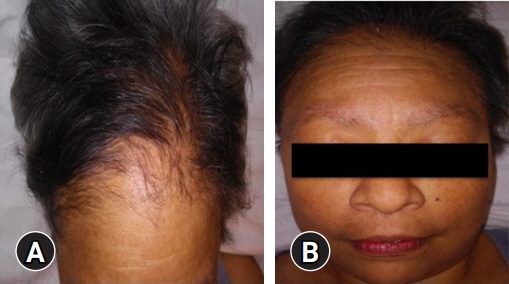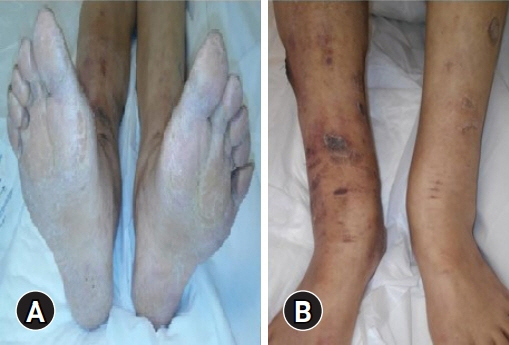J Yeungnam Med Sci.
2023 Jul;40(3):311-314. 10.12701/jyms.2022.00647.
Thallium poisoning: a case report
- Affiliations
-
- 1Department of Internal Medicine, Sanatorio de la Providencia, Buenos Aires, Argentina
- 2Department of Internal Medicine, Hospital Británico de Buenos Aires, Buenos Aires, Argentina
- 3Department of Internal Medicine and Hematology, Hospital Privado Santa Clara de Asís-IMAC, Salta, Argentina
- KMID: 2544595
- DOI: http://doi.org/10.12701/jyms.2022.00647
Abstract
- Thallium poisoning is usually accidental. We present a case of a 51-year-old woman who was evaluated in June 2018 for myalgia, vertigo, asthenia, and abdominal pain. Physical examination revealed temporal-spatial disorientation, jaundice, and asterixis. The laboratory reported the following: bilirubin, 10.3 mg/dL; aspartate transaminase, 78 U/L; alanine transaminase, 194 U/L; albumin, 2.3 g/dL; prothrombin time, 40%; and platelet count, 60,000/mm3. Serology performed for hepatitis A, B, and C; Epstein-Barr virus; cytomegalovirus; and human immunodeficiency virus was negative, and a collagenogram was negative. Physical reevaluation revealed alopecia on the scalp, armpits, and eyebrows; macules on the face; plantar hyperkeratosis; and ulcers on the lower limbs. Tests for lead, arsenic, copper, and mercury were carried out, which were normal; however, elevated urinary thallium (540 µg/g; range, 0.4–10 µg/g) was observed. The patient was treated with ᴅ-penicillamine 1,000 mg/day and recovered her urinary thallium levels were within normal range at annual follow-up. Thallium poisoning is extremely rare and can be fatal in small doses. An adequate clinical approach can facilitate early diagnosis.
Keyword
Figure
Reference
-
References
1. Gascó N, Martinez Y, Collado S, Junyent E, Pascual J. Acute intoxication by thallium: daily low-flux vs high-flux hemodialysis. Enf Neurolog. 2017; 20:10–1.2. Al Hammouri F, Darwazeh G, Said A, Ghosh RA. Acute thallium poisoning: series of ten cases. J Med Toxicol. 2011; 7:306–11.3. Rangel-Guerra R, Martínez HR, Villarreal HJ. Thallium poisoning: experience with 50 patients. Gac Med Mex. 1990; 126:487–95.4. Huang CC, Shih TS, Liu CH. Acute thallium intoxication: an experience in Taiwan. Curr Top Toxicol. 2012; 8:33–41.5. García S. Surveillance of intoxications in Argentina and Latin America. Acta Toxicol Argent. 2016; 24:134–60.6. Sun TW, Xu QY, Zhang XJ, Wu Q, Liu ZS, Kan QC, et al. Management of thallium poisoning in patients with delayed hospital admission. Clin Toxicol (Phila). 2012; 50:65–9.7. Hoffman RS. Thallium toxicity and the role of Prussian blue in therapy. Toxicol Rev. 2003; 22:29–40.8. Rusyniak DE, Furbee RB, Kirk MA. Thallium and arsenic poisoning in a small midwestern town. Ann Emerg Med. 2002; 39:307–11.9. Meggs WJ, Hoffman RS, Shih RD, Weisman RS, Goldfrank LR. Thallium poisoning from maliciously contaminated food. J Toxicol Clin Toxicol. 1994; 32:723–30.10. Hoffman RS, Stringer JA, Feinberg RS, Goldfrank LR. Comparative efficacy of thallium adsorption by activated charcoal, Prussian blue, and sodium polystyrene sulfonate. J Toxicol Clin Toxicol. 1999; 37:833–7.11. Moore D, House I, Dixon A. Thallium poisoning: diagnosis may be elusive but alopecia is the clue. BMJ. 1993; 306:1527–9.12. Tromme I, Van Neste D, Dobbelaere F, Bouffioux B, Courtin C, Dugernier T, et al. Skin signs in the diagnosis of thallium poisoning. Br J Dermatol. 1998; 138:321–5.13. Riyaz R, Pandalai SL, Schwartz M, Kazzi ZN. A fatal case of thallium toxicity: challenges in management. J Med Toxicol. 2013; 9:75–8.
- Full Text Links
- Actions
-
Cited
- CITED
-
- Close
- Share
- Similar articles
-
- The pattern of uptake of 201 thallium chloride in various lung disease
- The Significance of Thallium-201 SPECT in the Diagnosis of Brain Tumors: Clinical Analysis
- A Case of Optic Atrophy following Methanol Poisoning
- Predicting the Response of Preoperative Chemotherapy in Osteosarcoma by Thallium-201 Scintigraphy
- Oculogyric Crises



